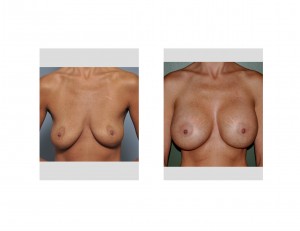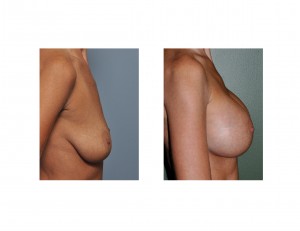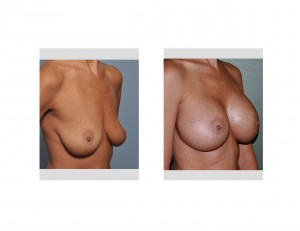Background: When women consider breast augmentation, they understandably spent an enormous amount of time focusing on the size of the implanted result. Along with that assessment comes the consideration of the breast shape which they assume comes from the effect of the implant. While this is somewhat true, there is also a strong influence of what one’s breasts initially looked like.
Generally speaking, breast augmentation can result in two basic shapes regardless of the implant’s size. One can either develop a rounder looking breast or one with a more tear-drop shape. The rounder look is for those women who want a lot of upper pole fullness and will have the ‘augmented’ look. For those women who want a more natural look, breasts that have a tear-drop shape are preferred. These types of implanted breast shape looks are highly personal and there is no right or wrong type of breast shape.

The use of a shaped breast implant is very useful for the women who definitely want to avoid a round full upper pole after surgery. It is also beneficial for those women that have pseudoptosis or type 1 ptosis and want to try and avoid the need for a breast lift. Having more volume on the lower pole of the implant allows it to provide a mild lift or filling out effect as opposed to pushing the sagging breast tissue down further when the more of the implant volume is higher up on the breast.
Case Study: This 38 year-old female had lost much of her breast volume after pregnancies and chemotherapy for lymphoma. (now disease free) She originally was a very full D cup and now just had a lot of loose breast skin. The nipple was just above the inframammary fold but substantial breast skin hung over it. (the definition of pseudoptosis)


Case Highlights:
1) The shape of the breast after augmentation is influenced by the shape of the underlying implant. While it is not always a one to one relationship, round implants tend to make rounder looking breasts.
2) Shaped breast implants have the ability to prevent too much postoperative breast ‘roundness’ of the upper pole.
3) To prevent shifting of a shaped breast implant after surgery, it has a textured surface which makes it necessary to place the implant through an inframammary fold approach.
Dr. Barry Eppley
Indianapolis, Indiana



